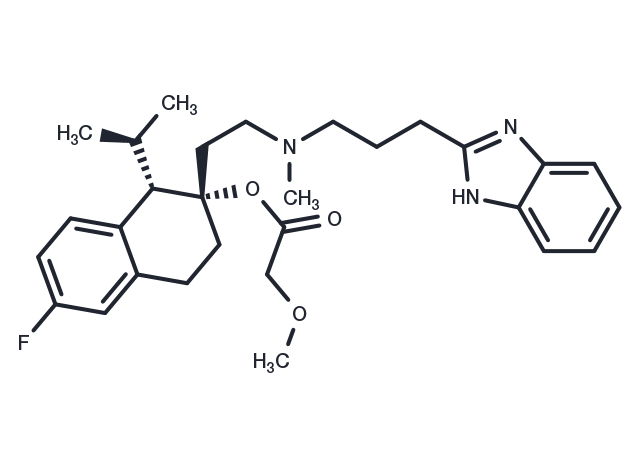Powder: -20°C for 3 years | In solvent: -80°C for 1 year


Mibefradil is a calcium channel blocker with moderate selectivity for T-type Ca2+ channels (IC50s: 2.7 μM and 18.6 μM for T-type and L-type currents).

| Pack Size | Availability | Price/USD | Quantity |
|---|---|---|---|
| 25 mg | 10-14 weeks | $ 2,420.00 | |
| 50 mg | 10-14 weeks | $ 3,180.00 | |
| 100 mg | 10-14 weeks | $ 4,300.00 |
| Description | Mibefradil is a calcium channel blocker with moderate selectivity for T-type Ca2+ channels (IC50s: 2.7 μM and 18.6 μM for T-type and L-type currents). |
| Targets&IC50 | Ca2+ channel, L-type:18.6 μM, Ca2+ channel, T-type:2.7 μM |
| In vitro | Mibefradil (Ro 40-5967) blocks T-type current already at a holding potential of -100 mV [1]. At a higher concentration (20 μM), Mibefradil reduces the amplitude of excitatory junction potentials (by 37±10 %), slows the rate of repolarisation (by 44 %) and causes a significant membrane potential depolarization (from ?83±1 mV to ?71±5 mV). At a higher Mibefradil concentration (20 μM) there is significant membrane potential depolarization and a slowing of repolarization [2]. |
| In vivo | The hearing thresholds of the 24-26 week old C57BL/6J mice differed following the 4-week treatment period. The hearing threshold at 24 kHz is significantly decreased in the Mibefradil-treated and benidipine-treated groups compared with the saline-treated group [3]. Compared with the saline-treated group, rats receiving Mibefradil show significantly lower CaV3.2 expression in the spinal cord and DRG [4]. |
| Animal Research | A total of 30 male C57BL/6J mice (age, 6-8 weeks) are randomized into three groups for the detection of three calcium channel receptor subunits α1G, α1H and α1I, using RT-qPCR. In addition, a further 30 C57BL/6J male mice (age, 24-26 weeks) are allocated at random into three treatment groups: Saline, Mibefradil, and benidipine. Each group is subjected to auditory brainstem recording (ABR) and distortion product otoacoustic emission (DPOAE) tests following treatment. Mibefradil and benidipine are dissolved in a physiological saline solution. A preliminary experiment led to the selection of dosages of 30 mg/kg/day Mibefradil and 10 mg/kg/day Benidipine. The drugs are administered to the mice by gavage for four consecutive weeks [3]. Male Sprague-Dawley rats (200-250 g) are used for right L5/6 SNL to induce neuropathic pain. Intrathecal infusion of saline or TCC blockers [Mibefradil (0.7 μg/h) or Ethosuximide (60 μg/h)] is started after surgery for 7 days. Fluorescent immunohistochemistry and Western blotting are used to determine the expression pattern and protein level of CaV3.2. Hematoxylin-eosin and toluidine blue staining are used to evaluate the neurotoxicity of tested agents [4]. |
| Synonyms | Ro 40-5967 |
| Molecular Weight | 495.63 |
| Formula | C29H38FN3O3 |
| CAS No. | 116644-53-2 |
Powder: -20°C for 3 years | In solvent: -80°C for 1 year
H2O: 95 mg/mL (191.68 mM), Heating is recommended.
Ethanol: 52 mg/mL (104.92 mM), Heating is recommended.
DMSO: 50 mg/mL (100.88 mM)
You can also refer to dose conversion for different animals. More
bottom
Please see Inhibitor Handling Instructions for more frequently ask questions. Topics include: how to prepare stock solutions, how to store products, and cautions on cell-based assays & animal experiments, etc.
Mibefradil 116644-53-2 Membrane transporter/Ion channel Metabolism Calcium Channel Ro 40-5967 inhibitor inhibit
